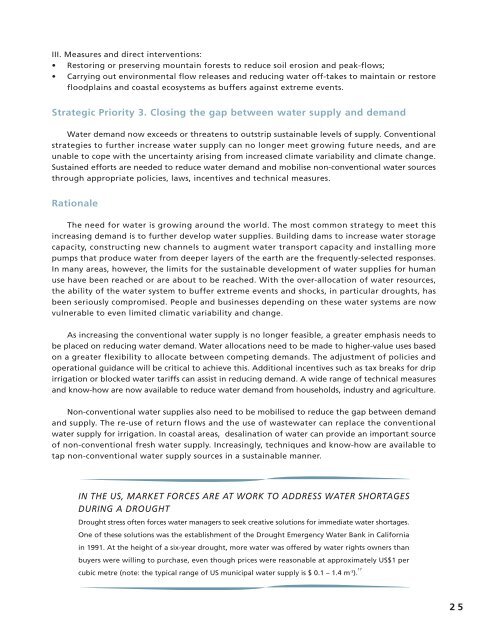Adaptation of water resources management to climate change
Adaptation of water resources management to climate change
Adaptation of water resources management to climate change
Create successful ePaper yourself
Turn your PDF publications into a flip-book with our unique Google optimized e-Paper software.
III. Measures and direct interventions:• Res<strong>to</strong>ring or preserving mountain forests <strong>to</strong> reduce soil erosion and peak-flows;• Carrying out environmental flow releases and reducing <strong>water</strong> <strong>of</strong>f-takes <strong>to</strong> maintain or res<strong>to</strong>refloodplains and coastal ecosystems as buffers against extreme events.Strategic Priority 3. Closing the gap between <strong>water</strong> supply and demandWater demand now exceeds or threatens <strong>to</strong> outstrip sustainable levels <strong>of</strong> supply. Conventionalstrategies <strong>to</strong> further increase <strong>water</strong> supply can no longer meet growing future needs, and areunable <strong>to</strong> cope with the uncertainty arising from increased <strong>climate</strong> variability and <strong>climate</strong> <strong>change</strong>.Sustained efforts are needed <strong>to</strong> reduce <strong>water</strong> demand and mobilise non-conventional <strong>water</strong> sourcesthrough appropriate policies, laws, incentives and technical measures.RationaleThe need for <strong>water</strong> is growing around the world. The most common strategy <strong>to</strong> meet thisincreasing demand is <strong>to</strong> further develop <strong>water</strong> supplies. Building dams <strong>to</strong> increase <strong>water</strong> s<strong>to</strong>ragecapacity, constructing new channels <strong>to</strong> augment <strong>water</strong> transport capacity and installing morepumps that produce <strong>water</strong> from deeper layers <strong>of</strong> the earth are the frequently-selected responses.In many areas, however, the limits for the sustainable development <strong>of</strong> <strong>water</strong> supplies for humanuse have been reached or are about <strong>to</strong> be reached. With the over-allocation <strong>of</strong> <strong>water</strong> <strong>resources</strong>,the ability <strong>of</strong> the <strong>water</strong> system <strong>to</strong> buffer extreme events and shocks, in particular droughts, hasbeen seriously compromised. People and businesses depending on these <strong>water</strong> systems are nowvulnerable <strong>to</strong> even limited climatic variability and <strong>change</strong>.As increasing the conventional <strong>water</strong> supply is no longer feasible, a greater emphasis needs <strong>to</strong>be placed on reducing <strong>water</strong> demand. Water allocations need <strong>to</strong> be made <strong>to</strong> higher-value uses basedon a greater flexibility <strong>to</strong> allocate between competing demands. The adjustment <strong>of</strong> policies andoperational guidance will be critical <strong>to</strong> achieve this. Additional incentives such as tax breaks for dripirrigation or blocked <strong>water</strong> tariffs can assist in reducing demand. A wide range <strong>of</strong> technical measuresand know-how are now available <strong>to</strong> reduce <strong>water</strong> demand from households, industry and agriculture.Non-conventional <strong>water</strong> supplies also need <strong>to</strong> be mobilised <strong>to</strong> reduce the gap between demandand supply. The re-use <strong>of</strong> return flows and the use <strong>of</strong> waste<strong>water</strong> can replace the conventional<strong>water</strong> supply for irrigation. In coastal areas, desalination <strong>of</strong> <strong>water</strong> can provide an important source<strong>of</strong> non-conventional fresh <strong>water</strong> supply. Increasingly, techniques and know-how are available <strong>to</strong>tap non-conventional <strong>water</strong> supply sources in a sustainable manner.IN THE US, MARKET FORCES ARE AT WORK TO ADDRESS WATER SHORTAGESDURING A DROUGHTDrought stress <strong>of</strong>ten forces <strong>water</strong> managers <strong>to</strong> seek creative solutions for immediate <strong>water</strong> shortages.One <strong>of</strong> these solutions was the establishment <strong>of</strong> the Drought Emergency Water Bank in Californiain 1991. At the height <strong>of</strong> a six-year drought, more <strong>water</strong> was <strong>of</strong>fered by <strong>water</strong> rights owners thanbuyers were willing <strong>to</strong> purchase, even though prices were reasonable at approximately US$1 percubic metre (note: the typical range <strong>of</strong> US municipal <strong>water</strong> supply is $ 0.1 – 1.4 m -3 ). 1725











![View full document [PDF 988.55 KB] - PreventionWeb](https://img.yumpu.com/47733942/1/184x260/view-full-document-pdf-98855-kb-preventionweb.jpg?quality=85)
![View full document (in French) [PDF 4.96 MB] - PreventionWeb](https://img.yumpu.com/47223870/1/184x260/view-full-document-in-french-pdf-496-mb-preventionweb.jpg?quality=85)


![View full document [PDF 25.02 MB] - PreventionWeb](https://img.yumpu.com/44204570/1/190x234/view-full-document-pdf-2502-mb-preventionweb.jpg?quality=85)
